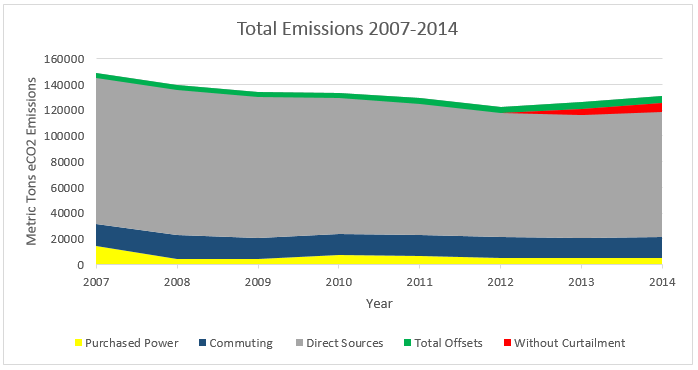UConn’s Climate Action Plan has led to the implementation of several notable projects and initiatives. The CAP outlines plans to improve sustainability under the following categories: transportation, energy, and sustainable development. In Spring 2012, UConn added an adaptation section to work in conjunction with its mitigation strategies. This section is focused on UConn’s research, outreach and service roles, as we seek to provide resources for improving the climate resiliency of communities throughout the state and region. The mitigation strategies in UConn’s Climate Action Plan serve to identify the emission reduction benefits and cost effectiveness of potential action items. The Office of Environmental Policy’s current emissions targets call for a decrease in emissions of 20% by 2020 and 30% in 2025. UConn’s overall progression includes:
- 134 relamping projects completed for more than $700,000 per year savings in energy costs and over 5,000 Tons eCO2 avoided
- 19 retro-commissioning projects completed for $2.2 million per year savings in energy costs and more than 12,000 Tons eCO2 avoided
- Several variable-frequency drive (VFD) projects optimizing heating and cooling in buildings for around 1,000 Tons eCO2 avoided
- Long-term electricity purchasing agreement with ConEd for 40% of purchased electricity compromised of renewable energy
- 26% reduction in water consumption on main campus, despite 11% increase in population served
- Agricultural/organic waste Composting facility operating at maximum load of 800 tons per year
- Connecticut Institute for Resiliency and Climate Adaptation (CIRCA) established in January 2014
- Obtained $2.14 million grant to install clean energy microgrid on Depot Campus. Grant enables 400. kW hydrogen fuel cell and 7 kw solar array to serve in island mode in the event of an emergency
- Signed Department of Energy’s Workplace Charging Challenge pledge: 3 active EV charging stations with more on the way
- Transportation fleet now includes 16 hybrid vehicles and 11 plug-in EVs, including the EStar campus van
With all of these developments, UConn continues to strive toward carbon neutrality and a reduction of greenhouse gas emissions in the years to come.

As it can be seen above, a 13.1% decrease in eCO2 emissions since 2007 was observed when the effects of curtailment were included. However, a 17.9% decrease in eCO2 emissions since 2007 was observed when the effects of curtailment were excluded. It can be noted that the direct emissions sources from the university are decreasing, but with more cold weather affecting the local area, the amount of curtailment days has continued to increase.
When the weather is especially cold and demand on the natural gas pipeline is high, UConn is forced to burn fuel oil instead of natural gas. On average, each day of natural gas curtailment results in 50,000 gallons of oil being consumed by the co-generation plant (an extra 500 tons eCO2 per day). In January 2014, UConn was forced to curtail natural gas consumption for 10 days, resulting in >600,000 gallons of oil being burned
In addition, new building construction has accounted for a majority of Direct Source Emissions increase in recent years. A breakdown of UConn’s emission sources can be seen below.
